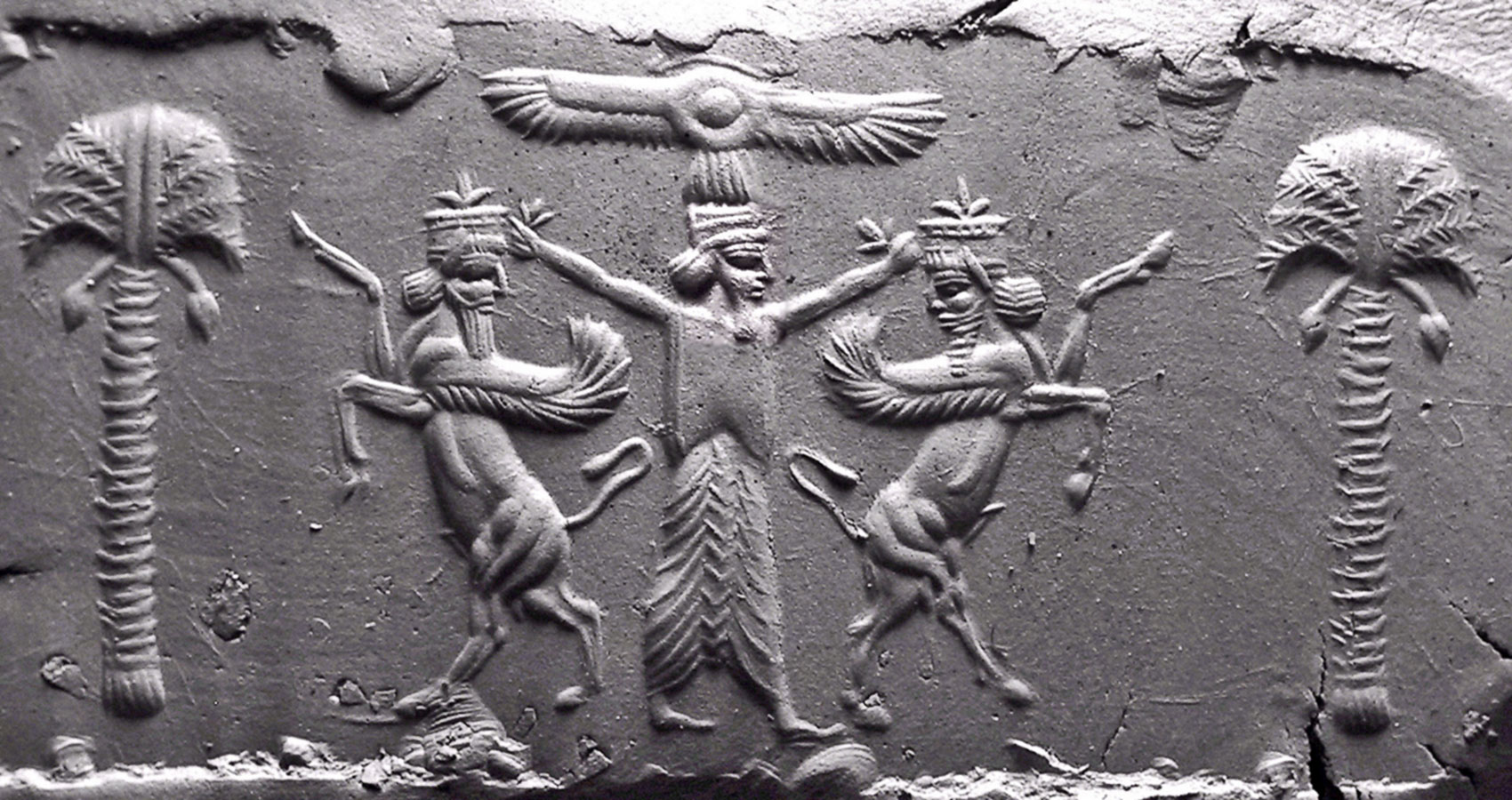Mesopotamian Legacy
written by: Stanley Wilkin
@catalhuyuk
Introduction:
This assignment is a follow-up to Myth of Ancient Greece, from ideas fully developed within The Myth of Mind and Consciousness. It is here proposed that the present global society owes more to ancient Mesopotamia than to Classical Greece, from where we pick and choose a beneficent relationship. The organised nature of present developed economic societies owes little to the largely small scale societies of Classical Greece. Our aspirations owe as much to Mesopotamia, especially via the monotheistic religions.
Sumeria.
In Sumerian thinking, naming was fundamental. Knowing words, or creating them, was an important element of early Middle Eastern urban cultures. Solomon knew the names of ‘birds and fishes’. Shuruppak, ‘the intelligent one, knew the words.’ This is the beginning of knowledge, assigning a name to an animate or inanimate object and bestowing upon it attributes and thereby associations and connections with other animate or inanimate things. In Genesis, God calls the universe into being by declaration. It involves noticing similarities and the nature of groupings. In that fashion they defined their environment and themselves, initiating a consciousness that might not have existed before. This theme is developed in The Myth of Mind and Consciousness.
Sumerian philosophy, which has come down to us, is contained within the lexical lists. From the time of early Uruk, when writing fully emerged for accounting and bureaucratic purposes, lists were made of birds, fish, cattle, pigs, trees, wooden objects, cities and regions, professions and titles. Leick (2001) notes that appropriate signs of a plant or animal preceded whatever plant or animal was being referenced, and that regions, professions and titles had abstract signs.
These lists form the basis for present day epistemology. Our investigative zeal, central to western science, can be traced back to this, the earliest culture dependent upon the written word. A tree is described with sub-headings referencing all parts of the tree, the relationship of each part, including its commercial use. The word for this, outside of a driving theoretical base, is scientific.
The pursuit of knowledge was not just utilitarian. It was an intellectual attempt to understand and control reality. Naming called into being the substance of a thing. Once something is named, subject to classification, another thing emerges and human reality grows exponentially. A tree is differentiated from a flower, thereby having properties that distinguish it from a flower. It has for example a hard stem. It is usually much larger and longer lived. These properties can be further abstracted into metaphors, such as sturdiness. That is, as sturdy as a tree. The properties of a tree allow tools to be made and huts built. The tree therefore has other identified properties that connect it to other things or objects. The identification of innate or discovered properties involves the expansion of cultural innovation. Jean Bottero holds that the name in ancient Mesopotamia was not an epiphenomenon, a pure accident extrinsic to the object, but provided its being from the source to which a name was attached. To receive a name and to exist were the same. Scripts were fundamentally concrete and realistic. Words, once written down, became a thing, allowing for scrutiny and analysis. Bottero declares that this makes the ancients very different from us, but many religious fundamentalists attach the same unbending properties to words that many others see as merely contingent. From the above process comes the growth and expansion of urban culture. Although the words are concrete, they take on an external property that creates building blocks for planning and other projected activity. Such a process confirms reality. A tree is not a flower and is further distinguished from other things, animate or inanimate.
I will provide an example from Sumerian literature.
‘After heaven had been moved away from earth,
After earth had been separated from heaven,
After the name of man had been fixed;’
The above, as with all Sumerian literature, has to be spoken aloud in an incantation. Not only does such a process confirm knowledge but it provides it with magical properties. The incantation establishes the existence of heaven and earth, but also the association between the two. Before this process, man (people) have come into existence through thought and naming. The allusion to fixed is to the properties of human beings differentiated from others, particularly deities. By this process, we now have knowledge of heaven and earth, their separate properties, and of the separateness of human beings. The Sumerians defined themselves, city-dwellers, and defined others beyond cities as possessing different attributes. It involves the creation of meaning.
The professional list is hierarchical or appears to be, but also demonstrates the communal relationship between members of the city-community.
Greek natural philosophers.
Possibly as early as the 7th century, ancient Greeks residing in Asia Minor became aware of Mesopotamian epistemology and this encouraged them to apply similar techniques to the world around them. They looked at the natural world and in an attempt to put meaning into natural phenomenon began seeking out relationships between the phenomena. They coined or borrowed abstracts in order to create reality. For example, fire had certain attributes, air possessed certain attributes, and each attribute was involved in eternal (also identified) processes. To reach this point took thousands of years but constituted a natural accumulative process acquired by the naming of things. The epistemological progress the Greek natural philosophers made was to reject religious aetiology and seek an alternative based upon properties acquired through naming of phenomena. Concrete understanding prevailed.
This article will not spend exhaustive time on Mesopotamian’s other intellectual achievements, Bottero references the scientific nature of divination, as the above is fundamental to Greek understanding of the world and advancing of that understanding. There is a direct link from the epistemology of the Sumerians to the more speculative philosophy of the ancient Greeks.
Only mathematics will be viewed as it once again is the root on which all present day mathematics, without recourse to knowledge of angles, is based. Multiplication, that things can grow, and division, that they can become less in value, creates a relationship between the one and the infinite. It defines wealth and poverty, and also our concept of time. While conceptually a pantheon can be understood, as with a royal family, as a cluster of individuals with different tasks and power, numbers can apportion value to the differences between them. Both the hierarchy and individual power is further defined. From this position proceeds a society, like our own, this is subject to values based upon numerical division. The distance from a king or high priest to the gods is further subject to numerical definition, allowing for numerous semi-divine characters to exist. The religious world of the Sumerians is therefore constructed upon mathematical values. One concept leads to the development of others, as the awareness of the separation of units allows for society to become increasingly complex.
As can be expected for a trading society, mathematics appeared early in Sumerian history. From 2000 BCE Mesopotamians employed place-value notation or positional number system. A small number of symbols were employed with amounts increasing or decreasing according to position. Based on 60, both multiplication and division was possible. But Mesopotamian mathematics was even more interesting. Kings and Gods were assigned numerical value, according to their position in the hierarchy, expressing a relationship and separation. They developed an algebra but without apportioning a graphic symbol for the unknown. This was provisionally indicated by 1 in order to find coefficients.
Mathematical sophistication was common to many early complex urban societies. The Fara tablets, found in situ within the buildings in which they were written, stored as archives, reveal the administrative complexity asserted above. At building XV, Tablet House, some 322 tablets were found indicating that 2000 people had worked there. Workers are often named. There is evidence of managerial units composed of between 20 and 100 employees. Outsiders were also noted; the gurus counted in units of 680. This appears to have been additional labour and often mercenary groups.
Gilgamesh:
The Gilgamesh poem (Myth of Mind and Consciousness) demonstrates conflict of city and the spaces between cities, civilisation and the natural world, predicting the same tension found in ancient Athenian literature. Through Gilgamesh and Enkidu, his doppelganger, different aspects of individual personality are examined. Parts of the poem investigate wholeness, of the importance of opposing values and sections coming together. The wholeness or completeness of the state is symbolised through the close relationship of Gilgamesh and, as is the coming together and severance of human divinity. In that sense, it describes the growing independence of human beings from reliance on gods. This is further illustrated by Gilgamesh’s despair at the knowledge of his physical decline and mortality. The poem is rich and complex, dealing with journeys to Anatolia, during which Gilgamesh and Enkidu’s friendship becomes stronger, separation and rejection of the gods and the final journey towards death. It is a remarkable piece of literature probably composed by several hands.
The poem has many of the themes of later literature, including Greek. The Iliad is evident in its concept of struggle and goals to be achieved, of enemies overcome, tasks completed. More relevant is perhaps the epic of Lugalbanda, who marching to invest a city becomes ill and turns into a demi-god or hero blessed like Achilles with super powers. The theme of journeys is thereby established early, symbolising that of the journey towards extinction. Mesopotamian literature, because of its unexciting surface, is neglected but it contains some of the most outstanding literature in the world. Like Athenian literature, it is often concerned with problems overcome and lessons learned. It is about wisdom.
The Mesopotamians employed dialogue as a means of constructing wisdom, many thousands of years before the same expository method was used by Plato, and, perhaps his predecessors. It is used to bring out correct behaviour expected within an environment, towards others, and within an event. It is likely these were recited by two speakers taking particular roles. Although they probably were spoken in the temples, that is where theatre began and belongs. It is revelatory, revealing something to the other in the dialogue.
An examination of ancient Mesopotamian society, sciences and literature suggests it provided the foundation for modern societies, the template for the development of urban culture based upon division into units, the building blocks for cities and states. It constructed reality based upon naming, the power invested in naming and classifying, the identification of relationships between the units. Our present societies are more clearly built upon this early grabbling with the environment than on its distant offspring, ancient Greece.
Conclusion:
Mesopotamian writing and mathematics occasioned a sense of space and positioning, the notion of things and ideas as events, which lead to a geographic absorption with the environment that allowed for the constant repetitive reconstruction of reality.
Merlin Donald avers that preliterate societies were culturally limited by their memories, the limitations on referencing. This places constraints on thought. They were restricted to narrative and mimesis. Required behaviour was transferred by metaphor. Writing externalises memory allowing for manipulation of material reality. From its beginnings in Mesopotamia, writing soon gave rise to abstractions.
Mesopotamia provided an early pantheon in which each deity had characteristics that reflected the natural world and then urban life. The personification of urban life was Inanna, the deity of love and war. Through these signifiers constructs of urban life, for example, were developed over thousands of years, leading to cities and then empires. The nature of urban roles and worship was established, of relationships, of love, of sin and evil. Those elements we take for granted, an urban society with extensive bureaucracies, armies, wars, organised religion and deductive thinking may be just one form of reality, a contingent reality shaped from the challenges of early Mesopotamian culture.
- A Strange Place - December 5, 2025
- The Puppet Dance - August 15, 2025
- Until I Stopped - April 23, 2025



